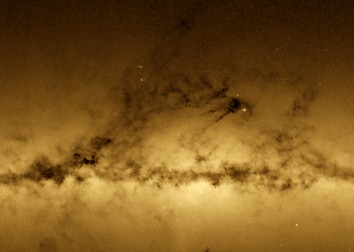Create a free profile to get unlimited access to exclusive videos, sweepstakes, and more!
This Is NOT the Milky Way. Except It Is.

In 2013, the European Space Agency launched the Gaia astronomical observatory. Its mission: Map the positions and motions of a billion stars in our galaxy. Yes, a billion.
The first data release was pretty cool, and some of the early release images were lovely as well. In 2015 the ESA released a nifty map of the Milky Way generated by Gaia data, but it wasn’t actually a photograph: They used engineering data from the observatory itself to map out where stars in the sky were, with denser patches mapped as brighter. Because the image is large and the resolution high, it looks like a photo.
They recently released a cleaned-up version of that map, which I’ve displayed above. This one is smoother looking and they used a different color scheme, but it still does the same thing: What you’re seeing is not an actual photo, but a map of where stars are on the sky.
It uses a galactic projection; the Milky Way is a flat disk, and we’re inside it. Because of that we see the disk spread out as a thick line across the sky. This image maps that so it goes across the middle of the frame, and the direction toward the galactic center is in the center of the frame as well.
You can see lots of features: The Milky Way really is pretty flat, for one. There’s a central bulge, decorated with ribbons and festoons of dark, light-absorbing dust, blocking the stars behind them. You can also see the two small satellite galaxies, the Large and Small Magellanic Clouds, to the lower right of the Milky Way’s disk. Various other patches are from globular clusters orbiting our galaxy.
I describe all these features in Crash Course Astronomy: The Milky Way:
Gaia is pretty amazing. It has ten primary mirrors, each about 1.5 x 0.5 meters, which collect starlight and focus them into two different cameras. The positions of the stars are measured with ridiculous precision, about 20 microarcseconds. An arcsecond is an apparent size on the sky; the Moon is 1,800 arcseconds across, for example. A microarcsecond is a millionth of an arcsecond, so Gaia will map the sky with incredible accuracy*.
This allows it to measure parallax, the apparent change in position of a star as the Earth moves around the Sun in its orbit (why yes, of course I have another Crash Course Astronomy episode which explains this in detail). This means Gaia will map not just the positions but also the distances to those billion stars it sees. Moreover, it can take spectra, breaking the light into colors. Astronomers use that information to find out what kinds of stars they’re seeing, they’re chemical composition, and more (yup: See Crash Course Astronomy: Light for more on that).
All in all, Gaia will be a huge resource for astronomers for many decades to come. And if all this hasn’t boggled your mind yet, think on this: Although it will map a billion stars, Gaia will only see less than one percent of all the stars in our galaxy.
Galaxies are mind-crushingly vast collections of stars. We’re only scratching the surface with Gaia… but how else will we ever get to the fun inner parts if we don’t get through the surface first?
* Correction, Nov. 19, 2016: I originally wrote that a microarcsecond is a billionth of an arcsecond, not a millionth.


























